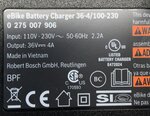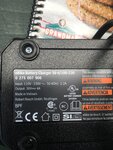I continue to hit brick walls trying to do this, not impossible, just in-efficient.
My current setup, less than 75% efficient contains:
A few cheap folding blanket solar panels (Allpowers) in parallel (approx 15VDC) totaling 160W max (160W minus 30% = 112W).
Victron Smartsolar MPPT 75/15 charge controller.
Self made LifePo4 battery pack with BMS - 12.8VDC 2.4Ah containing 4 x 26650 cells.
Redarc 350RS Pure Sine inverter - up to 350W, 12V , 200-240VAC.
Bosch Compact charger (2A).
Delphi Weatherpack connectors.
eg. Solar Panel --> Charge controller --> and/or LifePo4 battery --> Inverter --> Bosch charger --> Bike
So this is essentially DC to Storage/Control to AC and then back down to 36VDC! Hence why conservatively less than 80% efficient!
- This will take 2 good sunny days in Ozzie sun to charge both batteries (2 x Powertube 500) from flat to full
AND all this weighs approx 6.2kg! I could shave off a few kilos with P3 Solar folding panels (https://p3solar.com/portfolio/p3-75w-12v-portable-solar-charger/) but they are extremely expensive, could also try a Modified Sine inverter (even less efficient) and save another kg.
Has anyone tried a modified sine inverter with any of the Bosch chargers?
And please don't suggest i carry a small generator
I would love to purchase 1 or 2 Bosch Travel chargers (12VDC input, 2A) but they don't make them anymore and nobody has any to sell
With the standard Bosch charger (4A) i've found that if it doesn't get the 190+ watts it needs it shut's down. This would require a much larger capacity storage battery for when the sun is behind clouds to stop it from starting/stopping too often/quickly, and also 250W+ of solar panels.
I've found that the Compact charger (2A) whilst liking approx 95W of power will continue to operate below that level.
I've found that someone said that if you simply supply 5VDC to the signal line on a Bosch connector you can fool the battery into accepting charge (36VDC).
This would be so much nicer! I'd still keep the charge controller and small battery (for cloud conditions) but eliminate an DC-AC conversion stage. Plus power input to the bike batteries could be more dynamic depending on the solar.
Also found this on ebay: https://www.ebay.com/itm/172786244901?ul_noapp=true
But not much information is given and am not sure how it works, maybe just a 36VDC -> 5VDC converter is embedded into the plug?
Here's hoping anyone else out there has had any luck with solar charging.
My current setup, less than 75% efficient contains:
A few cheap folding blanket solar panels (Allpowers) in parallel (approx 15VDC) totaling 160W max (160W minus 30% = 112W).
Victron Smartsolar MPPT 75/15 charge controller.
Self made LifePo4 battery pack with BMS - 12.8VDC 2.4Ah containing 4 x 26650 cells.
Redarc 350RS Pure Sine inverter - up to 350W, 12V , 200-240VAC.
Bosch Compact charger (2A).
Delphi Weatherpack connectors.
eg. Solar Panel --> Charge controller --> and/or LifePo4 battery --> Inverter --> Bosch charger --> Bike
So this is essentially DC to Storage/Control to AC and then back down to 36VDC! Hence why conservatively less than 80% efficient!
- This will take 2 good sunny days in Ozzie sun to charge both batteries (2 x Powertube 500) from flat to full
AND all this weighs approx 6.2kg! I could shave off a few kilos with P3 Solar folding panels (https://p3solar.com/portfolio/p3-75w-12v-portable-solar-charger/) but they are extremely expensive, could also try a Modified Sine inverter (even less efficient) and save another kg.
Has anyone tried a modified sine inverter with any of the Bosch chargers?
And please don't suggest i carry a small generator
I would love to purchase 1 or 2 Bosch Travel chargers (12VDC input, 2A) but they don't make them anymore and nobody has any to sell
With the standard Bosch charger (4A) i've found that if it doesn't get the 190+ watts it needs it shut's down. This would require a much larger capacity storage battery for when the sun is behind clouds to stop it from starting/stopping too often/quickly, and also 250W+ of solar panels.
I've found that the Compact charger (2A) whilst liking approx 95W of power will continue to operate below that level.
I've found that someone said that if you simply supply 5VDC to the signal line on a Bosch connector you can fool the battery into accepting charge (36VDC).
This would be so much nicer! I'd still keep the charge controller and small battery (for cloud conditions) but eliminate an DC-AC conversion stage. Plus power input to the bike batteries could be more dynamic depending on the solar.
Also found this on ebay: https://www.ebay.com/itm/172786244901?ul_noapp=true
But not much information is given and am not sure how it works, maybe just a 36VDC -> 5VDC converter is embedded into the plug?
Here's hoping anyone else out there has had any luck with solar charging.
Last edited:


